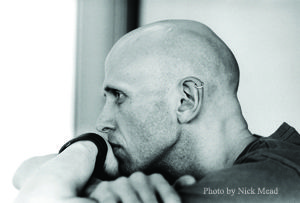
Wayne McGregor | Random Dance was one of many British companies to emerge in the 1990s but two features made McGregor’s work stand out. The first was the unique quality of his vocabulary; this had its origins in McGregor’s own long, lean and supple physique and in his body’s ability to register movement with peculiar sharpness and speed; at one extreme McGregor’s dancing was a jangle of tiny fractured angles, at the other it was a whirl of seemingly boneless fluidity.
The second outstanding feature of his work was its embrace of new technology. McGregor started playing with computers when he was seven and it was natural for him to incorporate the cyber world into his own choreography. Collaborating with state-of-the art designers, he experimented with projecting computer generated images onto the stage. In Sulphur 16 (1998) dancers were dwarfed by the presence of a shimmering virtual giant and danced with a company of digital figures that wove and shimmered among them like visitants from another age. In Aeon (2000), digitally created landscapes transported the dancers to what seemed like other dimensions and other worlds. McGregor has also used technology to alter the conditions under which his work is viewed. 53 Bytes (1997) was created for simultaneous performance by two sets of dancers in Berlin and Canada, and was watched by audiences in both countries by live satellite link.
McGregor has always been as curious about the technology of dancers’ bodies as he has been about machines. The stimulus for AtaXia (2004) was provided by the Experimental Psychology department at the University of Cambridge where McGregor, appointed Research Fellow, was engaged in a study of body-brain interaction. For Dyad 1909 (2009), he embarked on a study of creative cognition, with his entire creation process video-recorded and mapped by a team of cognitive scientists and students at the University of California, San Diego (USA). Entity (2008) and FAR (2010) have been other steps on this journey. UNDANCE (2011) saw him collaborate with Turner Prize-winning artist Mark Wallinger and composer Mark-Anthony Turnage.
In 2006, Wayne McGregor was appointed Resident Choreographer of the Royal Ballet, the first contemporary dance-maker to be given that post in the company’s history. A string of productions including Qualia (2003) and Engram (2005) were followed by the 2006 smash hit Chroma. Next came Nimbus (2007), and in 2008 McGregor organised a new festival for the Royal Opera House – Deloitte Ignite – which also saw the premiere of a new work, Infra. McGregor then conceived, directed and choreographed an historic joint collaboration between the Royal Ballet and the Royal Opera – the baroque double bill of Acis and Galatea and Dido and Aeneas. McGregor went on to create Limen (2010) and Live Fire Exercise (2011) for the Royal Ballet, which included ground-breaking collaborations with visual artists Tatsuo Miyajima and John Gerrard respectively. Most recently for the Royal Ballet, McGregor choreographed Raven Girl (2013) with award-winning author Audrey Niffenegger, Amber (2013) for Natalia Osipova for a Royal Opera House gala, Machina for Metamorphosis: Titian 2012 (2012) with sculptor Conrad Shawcross (co-production with the National Gallery) and Carbon Life (2012) with an all-star line-up of musicians including Mark Ronson, Andrew Wyatt, Boy George and Alison Mosshart.
Outside the world of “pure” dance McGregor has directed operas for La Scala in Milan and the Royal Opera House in London as well as producing the choreography for films, plays, musicals, fashion shows and art galleries including site-specific installations at the Hayward Gallery, Saatchi Gallery, National Gallery, Canary Wharf, Glastonbury, the Pompidou Centre and Secret Cinema in addition to movement for films and music videos ranging from Harry Potter and the Goblet of Fire to Radiohead’s 2011 Lotus Flower video (with almost thirty million views on YouTube) and Atoms for Peace’s 2013 video for Ingenue.
His creations for other dance companies have included pieces for the Ballet of the Opéra de Paris, San Francisco Ballet, Stuttgart Ballet, New York City Ballet, Australian Ballet, English National Ballet, NDT1 and the Rambert Dance Company. His works are also in the repertories of such leading international ballet companies as the Bolshoi, Royal Danish Ballet, National Ballet of Canada, Boston Ballet and Joffrey Ballet. In 2013 he premiered Atomos, the newest work for Wayne McGregor | Random Dance as well as Borderlands for San Francisco Ballet in January 2013, while in July 2012 he created Big Dance Trafalgar Square for the London 2012 Festival to celebrate the London Olympic Games.
Wayne McGregor has been the subject of a South Bank Show arts documentary (2009), and he features in Fred Wiseman’s feature-length documentary film about the Paris Opéra Ballet, La Danse (2009). He was the subject of Arte TV’s feature documentaries Wayne McGregor – A Moment in Time and Wayne McGregor – Going Somewhere, both directed by Catherine Maximoff. In 2012 he spoke at TED Global and was the subject of BBC’s HARDtalk.
Awards and honours:
Critics’ Prize for Chroma at the Golden Mask awards (Bolshoi Ballet, 2012), CBE (for Services to Dance, January 2011), the Prix de la Benois for Infra (Royal Ballet, 2009), “Choreographer of the Year” from Ballet Tanz (2009), the International Theatre Institute Award for Excellence in Dance (2009), the South Bank Show award for dance for Entity (Wayne McGregor | Random Dance) and Infra (Royal Ballet, 2009), the Movimentos Award for Entity (Wayne McGregor | Random Dance, 2009), three Critics’ Circle Awards (Amu, Wayne McGregor | Random Dance and Chroma and Infra, Royal Ballet), the Lawrence Olivier Award for Best New Dance Production for Chroma (Royal Ballet, 2007), the South Bank Show award for dance (Royal Ballet triple bill featuring Chroma, 2007), the Lawrence Olivier Award for Outstanding Achievement in Dance for 2Human (English National Ballet, 2004), two Time Out awards for Outstanding Achievement in Dance (2001, 2003) and the IMZ Dance Screen Award (2002).